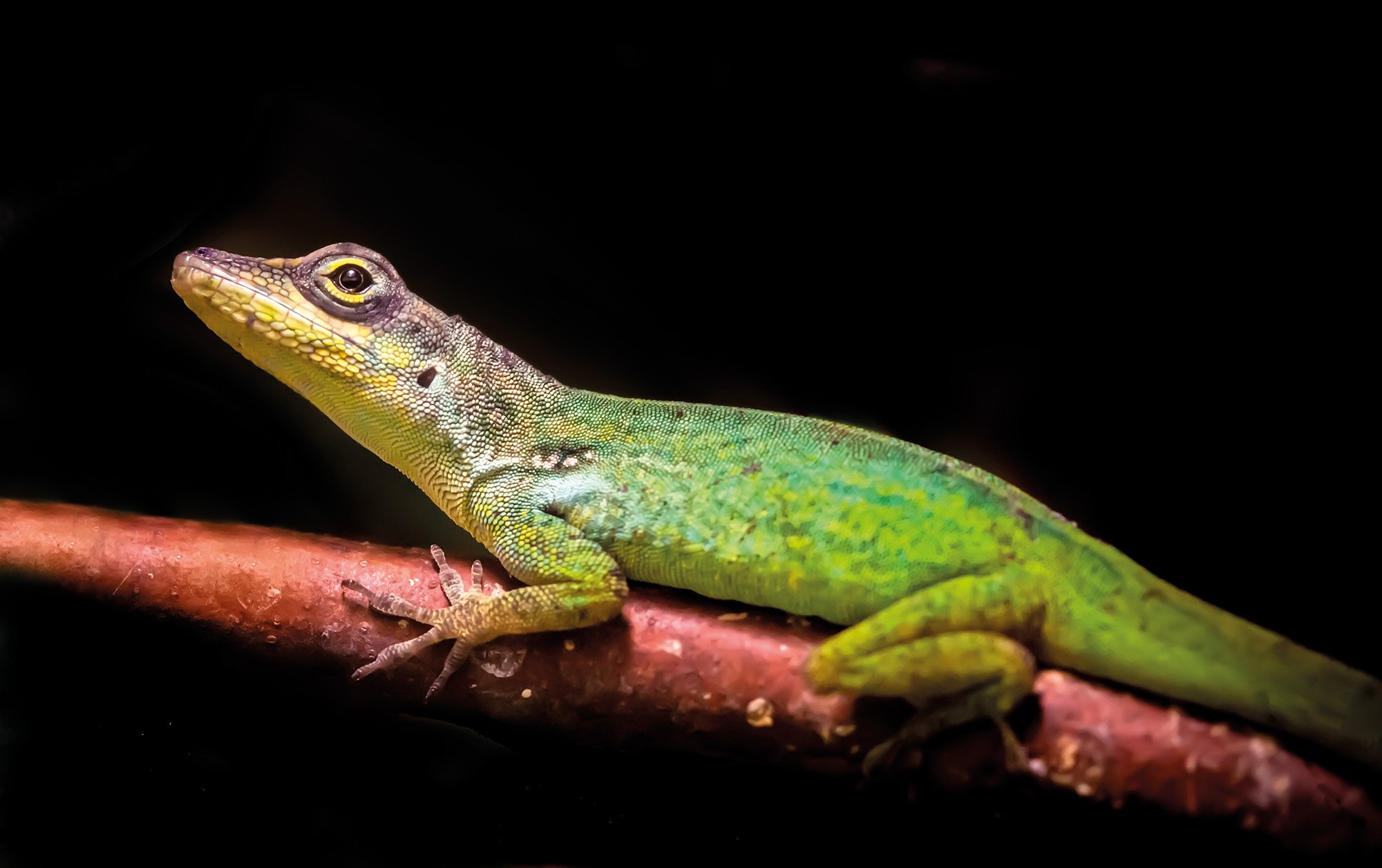Should I get a…
Martinique
spotted anole
The Martinique spotted anole, Anolis roquet summus, is endemic to Martinique and inhabits the central lowland forests. Here the temperature can reach the mid-30s °C with humidity near 100 percent in some parts of the year and the species is well suited to a nicely planted bioactive biotope terrarium. Indeed many of the anoles found in the Lesser Antilles have similar preferences.
Habitat niches
Adult males are often found high in the forest canopy, even basking on the crown of the trees. The females tend to prefer the safety of lower branches and trunks, while juveniles are often encountered near the ground.
This variation in microhabitats means that the sexes have evolved slightly differing body shapes and behaviours to deal with their preferred habitats.
On the larger Caribbean islands it is common to find several different anolis species, with the larger species being specialised tree-crown dwellers. The medium-sized anoles are trunk dwellers, while the smaller, slender anolis species will specialise in shrub or grass habitats. However, on smaller islands such as Martinique, Montserrat, and Dominica where there is only a single naturally occurring species, they have adapted to fill all of these habitat niches with the different sexes and life stages, allowing them to take advantage without being in direct competition.
Having said that, the sexes and life stages all overlap at times and for specific reasons. Males descend to lower branches for security, to hunt as well as to mate, while females drop down to the forest floor to lay eggs. If you have anolis in a large enough enclosure you’ll begin to realise that if you find a female on the floor and she isn’t hunting she’s more than likely looking for somewhere to lay an egg or two.
An Anolis roquet summus male
displaying his throat fan

Provide dry spaces to sit and bask, otherwise they can develop fungal skin infections.
Ben Baker
In captivity
Martinique spotted anoles are fairly straightforward to keep. A well-planted vivarium is a good start – think of a dart frog enclosure and you’re most of the way there, but add in vertical trunks and a basking spot over a roughly horizontal branch. Be sure to provide dry spaces to sit and bask, otherwise they can develop fungal skin infections. It’s also worth noting that the presence of the hot basking spot means you will have to be mindful of planting and fairly proactive when it comes to cutting back growth. Don’t let plants reach near the lamps or you might end up with a vivarium fire.
The basking spot needs to get hot – up to 35°C is acceptable although a little lower is usually okay as well. The ambient daytime temperature should range from 20°C at the coldest point, reaching 28°C at the top away from the basking site. At night the temperature can drop as low as 16°C but it’s safer to aim for 18°C.
As for relative humidity, around 75–85% is a good ambient, although if that rises to 90–95% after a misting that’s fine too. The anoles will cope, but while they like high humidity they don’t relish permanently wet conditions. As mentioned previously they need some areas to dry out completely. To support this I recommend adjusting the spraying or misting cycle to allow several mist-free hours to allow them to get properly dry before lights out. Overnight misting is not recommended.
Egg laying and incubation
Once you have your viv set up and the anoles are thriving, it won’t be long before you notice the female nuzzling in amongst the leaf litter. In this species, like many of the smaller Caribbean anoles, egg laying takes place on the ground and often in a shallow depression under leaves or nestled among roots and rocks. What’s also interesting is that multiple females will often use a communal egg site.
The individual eggs are small, around 8–10mm in length, and not quite spherical. Females can produce eggs every two or three weeks during the breeding cycle which takes place outside of the rainy season. This prevents the anolis eggs from being washed up by the cyclonic rainstorms. Eggs take just 42 days to incubate at 26–28°C and when the young emerge they are tiny replicas of the adult females.
Diet
Food tends to be in the form of crickets of any variety – black, brown, banded – they’ll eat them all. However they’ll only require a few at a time and will often leave a few running around for later, these hungry loose crickets can and frequently do damage plants and sometimes even attack lizards.
Neonates
At under 50mm long including tail these little guys will eagerly lap up fruit flies. But fruit flies aren’t a complete diet for them and to successfully rear the young anolis you will need to provide additional small-sized food items.
We offer them a wide variety including grain weevils, pea aphids, hatchling and first instar brown crickets as well as drosophila hydei flies and occasionally baby spiders such as Steatoda sp. The more variety the better, but even if you just have grain weevils or pea aphids then your survival rates of young anolis will increase.
Round up
These small, easily cared for lizards are highly active in small groups. By keeping a male with three females in a large vivarium you will be treated to the constant social behaviour that has made this family one of the most studied of all lizards. They will reward you with young and, given time, will even come and take food from your fingertips. Martinique spotted anoles are stunning lizards and certainly worth an extra vivarium if you have the time and space to care for them.
Ben Baker is the manager at Fantastic Frogs.
To enjoy more articles like this
Join RRK today
and receive our free digital magazine.





